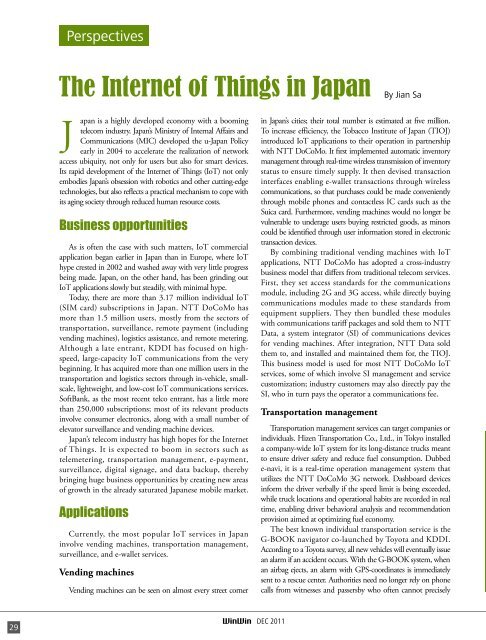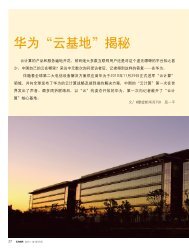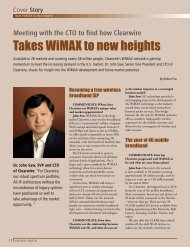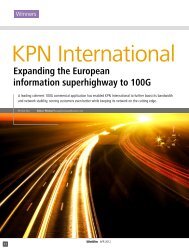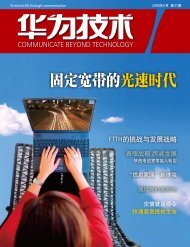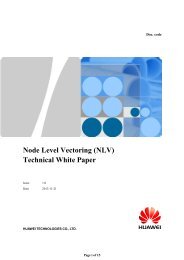Telekom Malaysia - Huawei
Telekom Malaysia - Huawei
Telekom Malaysia - Huawei
Create successful ePaper yourself
Turn your PDF publications into a flip-book with our unique Google optimized e-Paper software.
Perspectives<br />
The Internet of Things in Japan By Jian Sa<br />
J<br />
apan is a highly developed economy with a booming<br />
telecom industry. Japan’s Ministry of Internal Affairs and<br />
Communications (MIC) developed the u-Japan Policy<br />
early in 2004 to accelerate the realization of network<br />
access ubiquity, not only for users but also for smart devices.<br />
Its rapid development of the Internet of Things (IoT) not only<br />
embodies Japan’s obsession with robotics and other cutting-edge<br />
technologies, but also reflects a practical mechanism to cope with<br />
its aging society through reduced human resource costs.<br />
Business opportunities<br />
As is often the case with such matters, IoT commercial<br />
application began earlier in Japan than in Europe, where IoT<br />
hype crested in 2002 and washed away with very little progress<br />
being made. Japan, on the other hand, has been grinding out<br />
IoT applications slowly but steadily, with minimal hype.<br />
Today, there are more than 3.17 million individual IoT<br />
(SIM card) subscriptions in Japan. NTT DoCoMo has<br />
more than 1.5 million users, mostly from the sectors of<br />
transportation, surveillance, remote payment (including<br />
vending machines), logistics assistance, and remote metering.<br />
Although a late entrant, KDDI has focused on highspeed,<br />
large-capacity IoT communications from the very<br />
beginning. It has acquired more than one million users in the<br />
transportation and logistics sectors through in-vehicle, smallscale,<br />
lightweight, and low-cost IoT communications services.<br />
SoftBank, as the most recent telco entrant, has a little more<br />
than 250,000 subscriptions; most of its relevant products<br />
involve consumer electronics, along with a small number of<br />
elevator surveillance and vending machine devices.<br />
Japan’s telecom industry has high hopes for the Internet<br />
of Things. It is expected to boom in sectors such as<br />
telemetering, transportation management, e-payment,<br />
surveillance, digital signage, and data backup, thereby<br />
bringing huge business opportunities by creating new areas<br />
of growth in the already saturated Japanese mobile market.<br />
Applications<br />
Currently, the most popular IoT services in Japan<br />
involve vending machines, transportation management,<br />
surveillance, and e-wallet services.<br />
Vending machines<br />
Vending machines can be seen on almost every street corner<br />
in Japan’s cities; their total number is estimated at five million.<br />
To increase efficiency, the Tobacco Institute of Japan (TIOJ)<br />
introduced IoT applications to their operation in partnership<br />
with NTT DoCoMo. It first implemented automatic inventory<br />
management through real-time wireless transmission of inventory<br />
status to ensure timely supply. It then devised transaction<br />
interfaces enabling e-wallet transactions through wireless<br />
communications, so that purchases could be made conveniently<br />
through mobile phones and contactless IC cards such as the<br />
Suica card. Furthermore, vending machines would no longer be<br />
vulnerable to underage users buying restricted goods, as minors<br />
could be identified through user information stored in electronic<br />
transaction devices.<br />
By combining traditional vending machines with IoT<br />
applications, NTT DoCoMo has adopted a cross-industry<br />
business model that differs from traditional telecom services.<br />
First, they set access standards for the communications<br />
module, including 2G and 3G access, while directly buying<br />
communications modules made to these standards from<br />
equipment suppliers. They then bundled these modules<br />
with communications tariff packages and sold them to NTT<br />
Data, a system integrator (SI) of communications devices<br />
for vending machines. After integration, NTT Data sold<br />
them to, and installed and maintained them for, the TIOJ.<br />
This business model is used for most NTT DoCoMo IoT<br />
services, some of which involve SI management and service<br />
customization; industry customers may also directly pay the<br />
SI, who in turn pays the operator a communications fee.<br />
Transportation management<br />
Transportation management services can target companies or<br />
individuals. Hizen Transportation Co., Ltd., in Tokyo installed<br />
a company-wide IoT system for its long-distance trucks meant<br />
to ensure driver safety and reduce fuel consumption. Dubbed<br />
e-navi, it is a real-time operation management system that<br />
utilizes the NTT DoCoMo 3G network. Dashboard devices<br />
inform the driver verbally if the speed limit is being exceeded,<br />
while truck locations and operational habits are recorded in real<br />
time, enabling driver behavioral analysis and recommendation<br />
provision aimed at optimizing fuel economy.<br />
The best known individual transportation service is the<br />
G-BOOK navigator co-launched by Toyota and KDDI.<br />
According to a Toyota survey, all new vehicles will eventually issue<br />
an alarm if an accident occurs. With the G-BOOK system, when<br />
an airbag ejects, an alarm with GPS-coordinates is immediately<br />
sent to a rescue center. Authorities need no longer rely on phone<br />
calls from witnesses and passersby who often cannot precisely<br />
29<br />
DEC 2011


